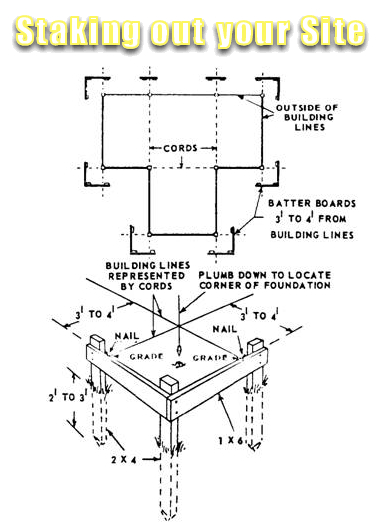|
Written by Frank McGill.
Ok, so you purchased one of our
Shed or
Gazebo
plans, and you are ready to begin work. You know what you
want to build and you are aching to start nailing boards
together. Well, not so fast buddy. There are a few
things you need to do before you start the actual construction
of your shed, even if you already have one of our great shed
plans and have read them fully. You need to
choose the right location, and properly layout your shed site
and stake out the location. This guide is meant to help
you through the process.
Choosing the Right Location for your Shed.
Before you begin, do
yourself a favor and consult with your local building department
and obtain information regarding the placement, height, and
square footage of outdoor storage buildings. You'd be
surprised what your local politicians have specified in the code
book. For example, your local codes might specify that
outbuildings cannot exceed a certain peak to ground height and
that a shed must be offset a certain distance from property
lines. If you disregard the code restrictions in your
municipality, you will create problems for yourself and your
neighbors. You might even be forced to remove a structure
that violates local code requirements or to pay a fine. If
your local code requires a permit, submit a site plan and shed
construction plans to your local building department and obtain
all necessary permits before you begin construction. This
is even more important if you don't get along with just one of
your neighbors, or just one of your neighbors is a busy body
with too much free time. Because, if you don't have all
your paperwork in order and one of your less then friendly
neighbors calls the building department, you can be shut down
before you know it.
Remember that your shed will serve as an important storage
addition to your home. With this goal in mind, be certain
to select a location that will make shed access convenient but
unobtrusive. Sketch a traffic plan that details major
access paths in your yard and around your home to help you
determine the correct location for your shed.
Consider the building location in relationship to existing and
future elements of your landscaping. Don't build a shed
next to a tree whose growing roots will displace the shed
foundation. Be certain that the placement of your shed in
your backyard landscape matches the planned use of the shed.
For example, if you want to use the shed in the winter, don't
place the shed on the north side of a large evergreen tree which
would completely block valuable winter sunlight.
If at all possible, always select a well drained location for
your shed. A spot with poor drainage or soft ground will
cause problems later on. Water accumulating under the shed
create condensation and can rust the materials you are storing
inside your shed.
Layout of the Shed Site.
Accurately locating the
four corners f the building will in turn establish the
boundaries for the foundation. The site is laid out using
batter boards set back from the corners of the planned building
in an L-shaped arrangement. Setting the batter boards back
from the actual building site allows you to maintain an accurate
reference point as you dig footings and construct the
foundation.
Batter boards are made of pointed stakes connected with 4'
lengths of 1x4 lumber. Each batter board should form an
accurate right angle when checked with a framing square.
Batter board tops must be level with each other all the way
around. Check for levelness with a string level or a
mason's line level.
A variety of shed foundation construction methods are available
depending upon your local site and your budget. If you do
not want to anchor the shed permanently to one location,
consider using wood skids and a wood floor foundation. If
you are ok with a permanent location, then using a concrete pad
foundation may be your best choice.
In areas where the ground does not freeze during the winter,
pier block foundations offer an inexpensive and sturdy method of
anchoring your shed foundation. Pre-cast pier blocks with
nailers are ready available at many building supply retailers
and provide a relatively simple foundation base for the first
time builder.
The more expensive and permanent alternative foundation is the
turned-down or monolithic concrete slab. Concrete has the
advantage of durability and resistance to moisture damage.
If you do select a concrete slab, make sure that your slab will
drain properly if moisture is released inside of your shed.
Drainage for concrete slabs is especially important for cabana
or greenhouse structures.
Staking out the Shed or Gazebo.
Refer to the diagram
below to layout your building.
1. Accurately locate one corner of the building mark
that corner with a stake driven into the ground.
2. Measure out along the long side of the building to the
next corner. Drive in another stake at this point.
Use a framing square to form an approximate right angle at this
corners. Measure out the approximate remaining corners of
your building and drive stakes along each corner. Run
twine from each stake to form your building perimeter.
3. You will now erect batter boards and adjust the stake
locations to form a true square or rectangular layout.
Erect bater boars so that each corner stake is line up directly
on the diagonal from the opssote corner as illustrated.
Use the line level to check that all batter boards are level
with each other.
4. Stretch mason's twine between the batter boards so it
is aligned directly over two of the stakes on one side.
When perfectly aligned, make a saw kerf in the batter boards to
make a permanent reference point and tack down the twine taut.
5. Stretch twine over the 2nd wall in your shed. It
must form a perfect right angle with the first wall. Check
for a perfect right angle using the
6-8-10 method.
6. Using the 6-8-10 method, lay out twine for the
remaining walls. At each corner carefully measure from the
point where the twine lines cross each other to set the building
dimensions. Drop a plumb line at this intersecting point
and set stakes in exact positions.
7. Check your dimensions on the final layout against your
shed plans by measuring the diagonals between the foundation
stakes. The diagonals must be equal in length if your
layout is truly square. If they are not, recheck your
measurements and make proper adjustments.
|
 |
Make sure you take a look at
our
shed plans pages and browse through our store. All of
our shed plans are available for immediate download. Here
you can buy our whole package, or just one of our plans as a
sampler. Our categories are always available on the left of
your screen on any page of our site.
|











